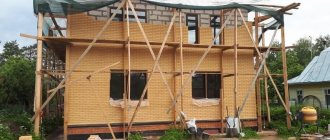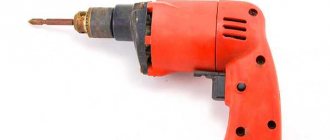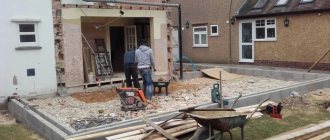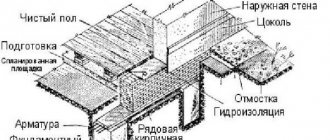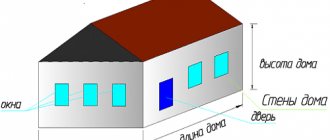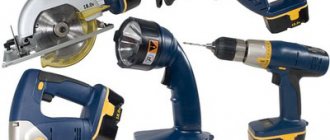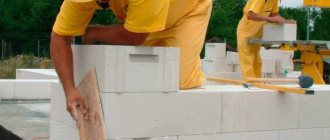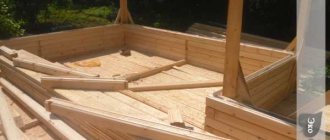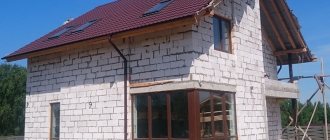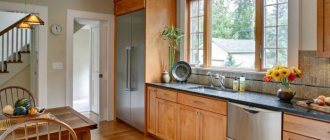What is brisolite
Brizolit is a natural building material; its production uses coniferous tree chips, special stabilizing additives and cement. The resulting mixture is poured into special molds, where it hardens, forming blocks of equal size with a cavity inside.
When constructing buildings, all that remains is to align the brisolite blocks evenly and connect them together with cement mortar. This installation technology reduces construction time and allows load-bearing walls to be installed in a few days.
Initially, brisolite was patented in Germany and this happened at the beginning of the 20th century. Since then, construction stone has been used in many construction projects and there are no particular complaints about its use. In Russia it is the only enterprise that produces these wall building blocks.
In order for brisolite to serve properly for decades, it must not only be manufactured in accordance with all quality standards, but also used correctly during construction. Compliance with installation conditions ensures the absence of distortions, cracks, good heat and sound insulation.
Technical characteristics, properties and composition
Brisolite blocks are produced on the basis of natural materials:
- Shredded wood, its percentage in the block reaches 80%
- Cement makes up 15% of a brisolite block.
- Five percent comes from mineral stabilizing additives.
Preservation of wood chips allows you to preserve all the properties of natural wood, and the introduction of cement and pressing provide the characteristics necessary for the construction of buildings.
Builders include the following properties of brisolite:
- High strength.
- Frost resistance - houses made of brisolite are built even in the northern regions.
- Fire resistance.
- Easy to install.
- The porosity of the manufactured blocks ensures optimal air circulation.
- Low weight, which ensures minimal load on the foundation.
- Possibility of installing sewerage and heating pipes directly into the blocks themselves, before pouring concrete.
The installation technology is not difficult. First, the blocks are aligned around the perimeter and stacked in two to three rows, then the joints between them are connected with reinforcement and concrete mixture. The appearance of the blocks can be rated 5 points - the internal walls of the brisolite are smooth, do not form visible transition points, and plaster and paint can easily be applied to them.
You can see what it looks like in the photo:
scheme for working with brisolite
brisolite laying process
removing brisolite walls
The brisolite itself does not have any significant disadvantages, but making a monolithic wall of a building can impair vapor permeability. This happens due to the foam included in the inside of the block, and due to the use of vapor-proof materials for interior and exterior decoration.
Therefore, monolithic houses made of brisolite require the development and installation of good ventilation, which increases construction costs. From this point of view, this material is not entirely practical; poor vapor permeability can be minimized by purchasing blocks with the highest quality insulation.
Table of the main technical characteristics of brisolite
Specifications
Brizolit can be called a natural and environmentally friendly material. To make such blocks, about 80% wood chips are used (as a rule, preference is given to coniferous wood), 15% cement and no more than 5% stabilizing and mineral additives. All components are mixed and sent to the press, going through the molding process. This allows you to create hollow but strong blocks.
If we talk about the properties of the material, it is worth highlighting:
- High strength of brisolite (21.6 kg/cm², which corresponds to class B1). This means that in terms of its strength characteristics the material is inferior to ceramic brick and corresponds to Twinblock (a type of cellular concrete).
- Density (volume weight) 341 kg/m³ (if we are talking about a standard ordinary block).
- Thermal conductivity up to 0.22 W/m °C (a sufficient value, according to standards, is 0.15 W/m °C).
- Frost resistance corresponding to class F25.
- Water absorption up to 10%.
- Permeability is about 0.11 mg/(m h Pa).
- Soundproof from 126 to 2000 Hz. For comparison, wood has almost the same indicator.
- Shrinkage no more than 0.59%.
Due to conservation, wood chips retain all the characteristics of the original material, and thanks to the introduction of a cement-sand mixture, the blocks acquire the required strength and other necessary construction characteristics. This is enough to erect reliable buildings of 2-3 floors.
Initially, the technology for creating building blocks from wood chips was patented in Germany. Later, standards and GOSTs were developed for the use of such materials in Russia.
Making brisolite with your own hands
In the production of brisolite blocks, the vibration pressing method is used. First, wood chips are treated with compounds that increase the wood’s resistance to fungi, microorganisms, mold, and high temperatures. Then put all the components into the mixer and mix thoroughly. This is necessary for the uniform distribution of all materials and to create a porous structure of the building stone.
Composition of brisolite
After mixing, the mass is poured into a vibropress, where blocks of different sizes are formed. The brisolite blocks are left on technological pallets to be fixed for a week, while the room must have a certain temperature and humidity level. After this, the next stage is started, at which the surfaces of the blocks are milled.
The result should be a building material with smooth sides. An ideal surface of the sides is necessary for a tight fit of the brisolite during installation. After milling, the blocks must go through a full maturation stage of two weeks. At this time, they are stored in warehouses and are no longer afraid of temperature changes.
The production technology is simple; production does not require special equipment; the main thing is to ensure the homogeneity of the composition and comply with the aging conditions. If desired, the production of brisolite blocks can be organized at the construction site itself, but this is advisable only if the building being constructed is large.
Sometimes, when making it yourself, it is impossible to achieve evenness of the outer walls of the blocks, and this is an indispensable condition for high quality and durability of the future structure. Therefore, the ease of self-production of blocks by specialists is rated three points.
This is what ready-made brisolite blocks look like
Composition and production technology
Initial components for manufacturing:
- cement – 15%;
- calibrated coniferous wood chips – 80%;
- stabilizing mineral additives – 5%.
The material is produced by vibration pressing:
- The components of the mixture are thoroughly mixed in a mixer.
- The homogeneous mixture is fed to a brick making machine, where blocks are formed on technological pallets.
- The finished blocks are placed in an intermediate warehouse, where over the course of a week, under conditions of constant humidity and temperature, they “ripen” and gain preliminary strength.
- Then the blocks undergo a process of milling the mating surfaces, which subsequently ensures their tightest fit to each other.
- Simultaneously with milling, thermal inserts are pressed into the cavity of the block, which significantly increase the thermal insulation properties of the material.
- After this, the blocks are placed on pallets and sent to a warehouse to fully mature for another two weeks.
After this, the blocks are completely ready for use and are not afraid of any atmospheric influences.
Although wood occupies a large volume in the block, during the mixing process it comes into contact with the binding solution, is enveloped in it and preserved, preserving all the properties of a living tree, but not accessible to the destructive effects of the atmosphere.
When stored outdoors for a long time, it is still better to cover pallets with blocks with moisture-proof material.
Application of brisolite
Brizolit has proven itself well in laying load-bearing and internal walls of low-rise buildings.
The building material is widely used:
- For the construction of private houses and cottages.
- For the construction of garages and warehouses.
- Brisolite is used as enclosing structures in the construction of highways.
- High soundproofness makes it possible to successfully use brisolite in the construction of subways.
Smooth walls made of brisolite, both on the outside and on the inside, can be finished with any material, ceramic tiles, facade panels, siding. The ease of installation allows you to build a private house with the help of two or three people, while the lightness of the material eliminates the need to rent heavy equipment for lifting blocks.
Projects and photos of finished houses built from brisolite
finished house made of brisolite and its design
building a house from brisolite
house made of brisolite in front of the roof deck
house made of brisolite at the stage of interior work
ready-made house project made of brisolite with finishing
Construction from Brisolite
The technology for constructing buildings from BRIZOLIT blocks is a construction technology using permanent formwork systems (fixed formwork forms part of the wall) and comes down to installing the blocks “dry”, without the use of leveling mortar, followed by reinforcement and monolithization of voids with concrete. A distinctive feature of permanent formwork made from BRIZOLIT blocks is that they are both insulation and part of the wall. The construction of buildings using permanent formwork systems is carried out in many countries around the world, including in countries with difficult climatic conditions.
In Russia, construction companies successfully use this technology for the construction of individual cottages, residential high-rise buildings, garages, administrative and industrial buildings.
A distinctive feature of permanent formwork elements is their low weight due to the materials used and design features. Installation of elements is usually carried out using mechanisms of low load capacity or without them at all. This explains the widespread use of permanent formwork systems for the construction of cottages. Permanent formwork systems are used when adding attics to existing buildings, since the dead weight of the structures is small and does not significantly affect the load-bearing capacity of walls and foundations. During the concreting process, the geometric immutability of the walls is ensured without the use of a leveling solution; vertical and horizontal layers of concrete are obtained. The frame of a house built from Brizolit blocks is a monolithic concrete lattice, thereby achieving the necessary structural strength.
Pros and cons of brisolite
When choosing any building material, the future owner of the building takes into account all the disadvantages and advantages.
The advantages of using brisolite include:
- Ease of use. Brizolit is quickly and easily installed and does not require the use of complex equipment. Ease of installation compared to other materials can be rated 5 points. After the walls are erected, their interior decoration can be carried out almost immediately.
- Durability, brisolite has high strength, does not deform, and does not rot.
- Highly environmentally friendly. The material is rated 5 points by health safety experts; brisolite contains wood and cement; a small amount of mineral additives is used only to increase resistance to high temperatures and humidity.
- Seismic resistance.
- Economical. Despite the fact that the price of a block of brisolite is at the level of 400-600 rubles, the total production costs are low. Cost-effectiveness is achieved by the rapid pace of construction, reduced use of energy resources to maintain heat in the house and durability of the material.
The disadvantages of brisolite include the rather high cost and the possibility of poor air circulation due to the use of low-quality finishing materials.
Brisolite is often compared to twin blocks, but these building materials should not be put on the same scale. The first is made by vibrocompression from environmentally friendly wood chips with additives, and the second is cellular autoclaved concrete consisting of cement, lime, aluminum powder and water. All this will affect the technical and operational properties of the blocks.
Reviews
Many private houses and industrial buildings have already been built from brisolite. Information about such houses from those people who have already lived in it for several months and survived the cold season is more reliable.
“We didn’t decide to use brizolit right away; the high price stopped us. But since there was no way to wait long (we had to move into the house as quickly as possible), we decided to build from blocks. The construction of all the walls was completed in a month, and the interior decoration did not cause any trouble, since the walls were perfectly smooth. In winter, the rooms were very warm, I used an electric boiler for heating and I won’t say that it was expensive” - Sergey, 38 years old.
“We wanted to immediately build a large and durable house, so that our children could live in it comfortably. We chose the project for a house made of brisolite, and we don’t regret it at all. The house turned out to be ideal - with smooth walls, warm, spacious, and there was no feeling of stale air. Thanks to the manufacturers of brisolite blocks” - Ivan, 43 years old.
Video about brisolite and a master class on building with it:
In what areas can brisolite be used?
The main area of application of the material is the construction of houses and utility rooms. Residential buildings made of brisolite can have up to 2 floors. In this case, both partition and load-bearing walls can be made from blocks. They are highly reliable and durable.
Brizolit is also often used as soundproofing structures to improve the public environment. Walls from it are erected within the city along busy highways and railway tracks. Brisolite sheets perform the same tasks during subway construction.

